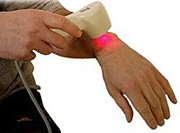 |
 |
|
|
Health Articles:
Alternative and General Health
Musculoskeletal Health
Nutrition and Herbs
Pediatric Health
Senior Health
Sports & Fitness
Women's Health
Ask A Doctor (Forum)
|
By Dr. William J. Kneebone With FDA approval and more than 30 years of research on its side, lasers might soon become a frontline treatment option for doctors looking to relieve patients' pain and accelerate injury healing. Laser/phototherapy has been used worldwide to treat more than 150 different conditions. What conditions usually respond to laser therapy? The list is long and includes joint sprains, muscle strains, swelling and inflammation in joints, pain associated with wounds and burns, muscle spasm, nerve pain, carpal tunnel syndrome, low back and neck pain, and various knee and elbow injuries. Physics researcher Theodore Maiman and his team gave the first public presentation of laser technology to the press at Hughes Research Laboratory in California on July 7, 1960. Its first medical application was for laser surgery in 1970. Dr. Anton Mester, a Hungarian physician, was the first to observe the tissue-healing effect of low-level laser irradiation while attempting to use a laser to treat cancerous tumors in rats in 1967. His unexpected observations opened up a whole new world of possibilities for wound healing, pain relief and many other exciting applications. This has come to be known as low-level laser therapy.
Medical lasers are regulated by the Food and Drug Administration (FDA). They are classified into one of five categories or classes. Classification is related to the potential for causing eye damage. Class 1 lasers are used in such things as television remotes or CD players and can't cause eye damage. Class 2 lasers are therapeutic and have a very low potential for eye damage. Class 3-A lasers are considered safe, but with some potential for eye damage possible. Class 3-B lasers are considered safe, but have more potential for eye damage. Class 4 lasers are very powerful and have significant potential for eye damage. It's important to note that when using any class of lasers, both doctor and patient wear laser safety glasses to filter out harmful infrared light. Thus, all therapeutic lasers are safe when used following established protocols.
Primary tissue effects are direct chemical effects on cells. They include increasing the production of ATP (adenosine triphosphate), which is the cellular fuel our body uses to function. The more ATP in our cells, the faster healing occurs. Laser irradiation of the cells also increases cell membrane permeability. This means waste products within the cell can be removed more efficiently and nutrients can move into the cell more quickly and efficiently. Secondary effects are chemical "chain reaction" effects that occur in response to the primary cellular effects. They include a decrease in nerve irritability, anti-inflammatory effects, and an increase in circulation at the site of injury or chronic pain. Tertiary effects include a variety of whole-body effects, such as increased immune cell production (lymphocytes); increased production of the body's own pain relievers, called endorphins; and improvement of nerve function. William J. Kneebone, DC, RN, CNC, studied nursing at Cook County Hospital in Chicago and chiropractic at Palmer College of Chiropractic in Davenport, Iowa. He has practiced complementary and alternative medicine in the Bay Area since 1978 and has utilized therapeutic laser therapy for more than seven years.  |

